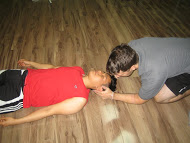
When driving pass a car accident one sometimes wonders whether or not to stop. Well the answer to that would be, “Would you want someone else to stop at your accident scene?” Now you are wondering what to do once you have stopped well here are a few tips.
1) Always approach the victim in their field of view. Never approach from behind as they will want to turn around to see who is approaching them. If you approach from out of their field of view and they have a Cervical Spine injury the turning of their neck will make the injury worse.
2) While approaching in their field of view introduce yourself and tell them not to move their head
Eg: Hi my name Faith, I am here to help you. Please do not move your head
3) Using the Glasgow Coma Scale assess the victim level of consciousness
a) The GCS is divided into three sections each mark out of a different amount that totals 15
- Eyes-4
- Verbal-5
- Movement-6
b) The score for each section given based on how the victim response to the responder
- Eyes
- Eyes open spontaneous upon approach-4/4
- Eyes open with verbal stimuli -3/4
- Eyes open when painful stimuli is applied-2/4
- Eyes do not open-1/4
- If there is damage to the eye that prevents it from opening give the person –C
- Verbal
- Oriented (when asked a question do they ask clearly and correctly)-5/5
- Confused( they form sentences correctly but sometimes do not know where they are or what year it is)-4/5
- Inappropriate Words( does not mean profanity it means they give the wrong answer for the context such as to the question where are you? They would answer “Fried Chicken”. They speak real words just out of context)-3/5
- Incomprehensible Sounds( they use sounds and words that do not fit into any language)-2/5
- No response-1/5
- If there is an injury that is preventing speech use
- Motor
- Obey Commands ( Such squeeze my finger of lift your arm)-6/6
- Localize the Painful Stimuli ( when you apply pressure anywhere they use their arm to push you always or just to grab your arm)-5/6
- Withdraw from painful stimuli( when pain is applied they try to move away from the pain)-4/6
- Abnormal flexion Posture( The muscle in the anterior arm contract while posterior muscle relax. This lead to the arm curling towards the body while the wrist are flex away.)-3/6
- Extension posturing( the limbs straighten for example the shoulder get closer to body and arms stick out away from body , it is the opposite to the flexion)-2/6
- No response-1/6
c) Below is an example of how a GCS is written up
- E-2/4
- V-4/5
- M-3/6
GCS-9/15
4) Carry out a total assessment of the patient before transportation occurs.
[youtube url=”http://www.youtube.com/watch?v=FihnmEx6Rqk”]